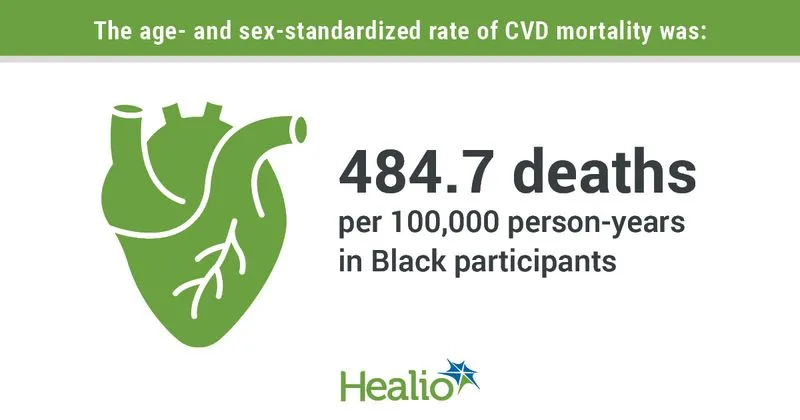August 14, 2023
2 min read
Source/Disclosures
Disclosures:
He reports no relevant financial disclosures. Please see the study for all authors’ relevant financial disclosures.
Key takeaways:
- The CVD mortality rate per 100,000 person-years was 484.7 in Black patients vs. 384.5 in white patients.
- The disparity dissipated after researchers adjusted for social factors.
Social determinants of health significantly contributed to high rates of CVD mortality among Black individuals compared with white individuals, according to researchers.
Prior research has suggested that social determinants of health, or SDOH, influence racial disparities in premature mortality rates among Black adults. Disparities in CVD have also been well documented, with Black adults showing greater prevalence of CVD risk factors like hypertension and obesity vs. white and Asian adults.

“However, data are scarce on the complex relationship of social, behavioral, and metabolic risk factors with racial differences in CVD mortality in a large, nationally representative sample in the U.S. population,” Jiang He, MD, PhD, a professor of epidemiology at Tulane University’s School of Public Health and Topical Medicine, and colleagues wrote. “Such information may be critical to guide the development of national public health policies for targeted interventions aimed at eliminating health disparities in CVD mortality.”
So, He and colleagues measured associations of social, behavioral and metabolic risk factors with CVD mortality using 1999 to 2018 National Health and Nutrition Examination Survey data from a cohort of 50,808 people aged 20 years and older.
They found that over an average of 9.4 years, 2,589 CVD deaths were confirmed, with 537 in Black individuals. The overall age- and sex-standardized rate of CVD mortality was 383 deaths (95% CI, 343.4-428.9) per 100,000 person-years.
Among population subgroups, the age- and sex-standardized rate of CVD mortality was:
- 484.7 (95% CI, 397.3-599.1) deaths per 100,000 person-years in Black participants;
- 384.5 (95% CI, 338.3-441.6) deaths per 100,000 person-years in white participants;
- 292.4 (95% CI, 217.8-402.7) deaths per 100,000 person-years in Hispanic participants;
- 255.1 (95% CI, 143.0-510.2) deaths per 100,000 person-years in other racial and ethnic groups.
Before adjustments, the HR in CVD mortality of Black participants compared with white individuals was 1.54 (95% CI, 1.34-1.77). He and colleagues noted that the HR decreased to:
- 1.34 (95% CI, 1.16-1.55) after adjustment for metabolic risk factors;
- 1.31 (95% CI, 1.15-1.5) after adjustment for behavioral risk factors; and
- 1.04 (95% CI, 0.9-1.21) after adjustment for social risk factors.
Behavioral risk factors included smoking, a lack of physical activity and sleep of less than 6 hours or more than 8 hours, whereas metabolic risk factors consisted of hypertension, obesity and diabetes.
The social factors linked to a greater risk for CVD mortality included unemployment, low family income, food insecurity, a lack of home ownership and not being married to or living with a partner.
“Being married or living with a partner may be a proxy for several important factors, including greater social support and a healthier lifestyle,” the researchers wrote.
They added that past studies have also shown food insecurity to be linked to poor nutrition and CVD risk factors, and noted both findings warrant future studies.
The study had several limitations, according to the researchers. For example, the number of deaths from stroke and heart disease were too small to conduct a cause-specific analysis. Additionally, social, behavioral and metabolic risk factors were gathered cross-sectionally, “so causal ordering among these risk factors with CVD mortality could not be studied,” the researchers wrote.
He and colleagues concluded that more research is needed “to understand the underlying mechanisms of SDOH on CVD mortality and develop novel interventions for reducing CVD mortality in populations, especially in Black persons.”


